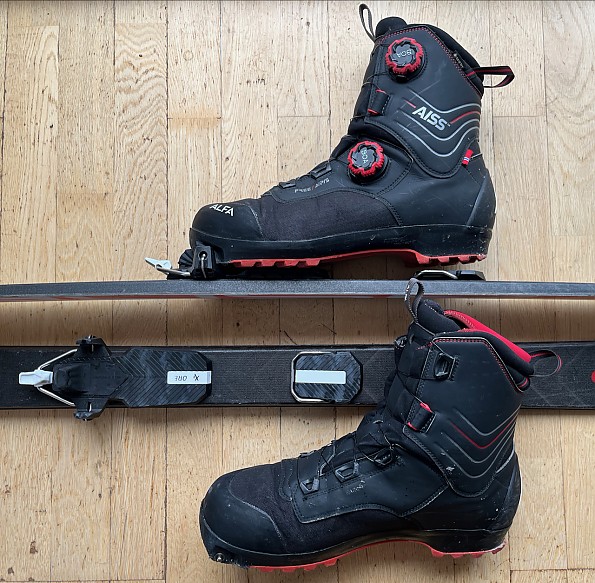Alfa Free A/P/S GTX
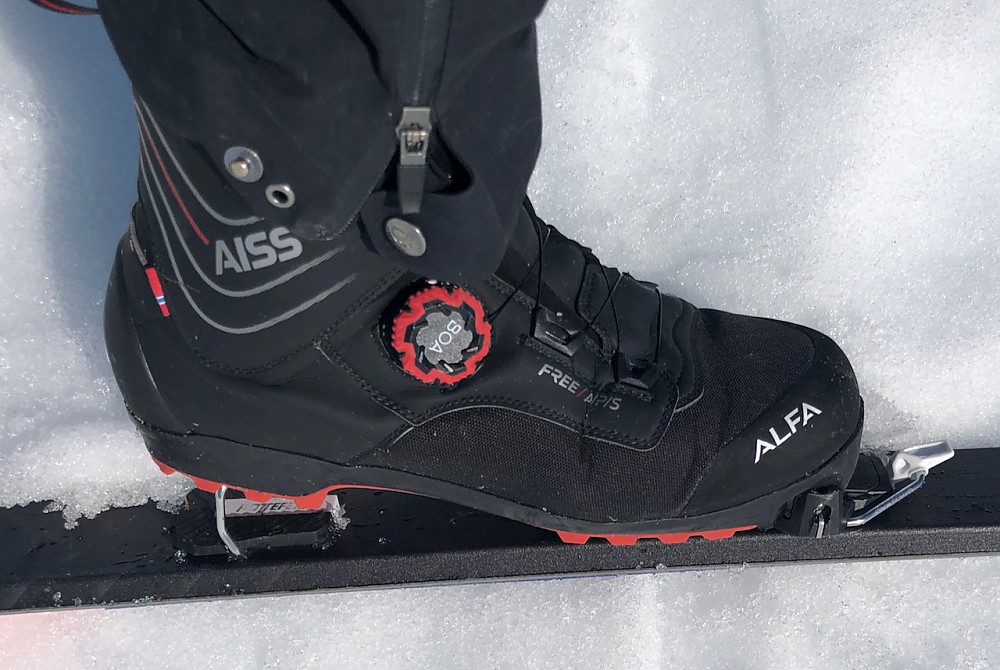
A high-end boot for the Rotteffella's new Xplore backcountry binding system. Torsionally rigid sole and ankle stiffeners for downhill performance. BOA lacing for easy entry and exit plus Xplore's step-in and-out functionality add up to a lot of convenience. A great choice for tours-for-turns type skiing, especially hut-to-hut with downhill fun on the side.
Pros
- Solid design and construction
- Torsionally rigid Xplore sole and ankle stiffeners give good turning performance in a (mostly) leather boot
- Dial-in BOA lacing system for easy entry, exit, and adjustment
- Step-in and -out convenience with Xplore binding
Cons
- Heavy compared to some other Xplore boots
- BOA not for everyone?
- Soft rubber heel vulnerable to damage
The Norwegian outdoor footwear company Alfa was one of the first to produce ski boots compatible with the Rottefella’s new Xplore backcountry binding system. This review of the Free, Alfa’s top-of-the-line offering, goes along with my reviews of the Xplore binding and the Åsnes Rabb 68 ski, which I purchased together as a package deal. I have been test driving the system mainly in Bymarka, a big city forest park in Trondheim with a couple hundred kilometers of groomed xc ski trails and a lot of untracked space in between, including some quality powder stashes, but also on some forays into the Norwegian mountains.
The Free is a high and relatively stiff Nordic boot for backcountry touring on mixed terrain, including moderately steep downhill runs in good snow conditions. It is especially well-suited for hut-to-hut touring with some side action on tempting slopes and summits.
The Free is one of the first Nordic touring boots to employ the “dial-in” BOA lacing system, allowing quick and easy entrance and exit and adjustment on the fly. Alfa also offers Xplore-compatible traditional lace up boots.
Materials and construction
Alfa boots are designed in Norway and made in Italy with high quality materials and construction. The forefoot is made of tough cordura, with a rubber toe cap for extra protection. The heel and ankle are leather, with some exposed stitching that may wear out over time, especially around sharp ski edges, but after two seasons mine are holding up well. Alfa’s AISS ankle support system consist of stiffeners hidden in the ankle and anchored to a sturdy heel cup to provide more edge control.
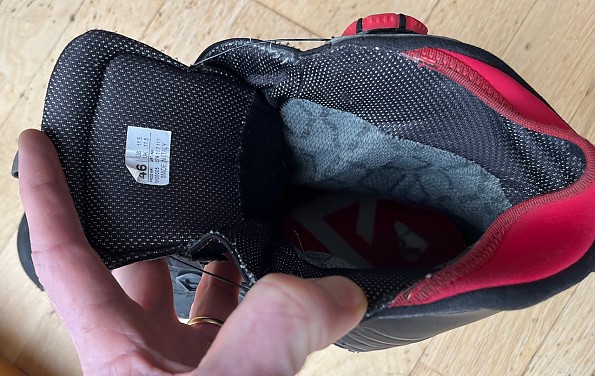
A partial stretch fabric cuff around the back of the ankle seems to be intended to keep snow out, but I wouldn’t count on it—that’s a job for gaiters or over-the-boot ski pants. The interior is comfortably lined and padded, with a Gore-tex liner to keep liquid water out. On a late spring tour I had to cross a few hundred meters of boggy terrain to reach snow and my feet stayed dry. The boots are insulated for cold conditions, with a layer of dense foam padding around the ankles for when they are cranked tight in downhill mode. Hidden in there somewhere, presumably in booth boots, is a RECCO chip to help locate the boots and, hopefully, wearer in the event of avalanche burial.
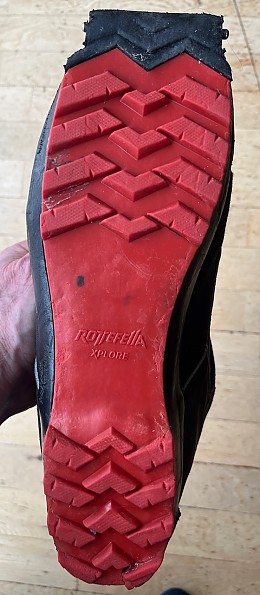
The outsole is made of hard rubber in front, around the Xplore pin mechanism, while the red part is a soft, grippy rubber blend with a zigzag waffle pattern that gives good traction in snow.
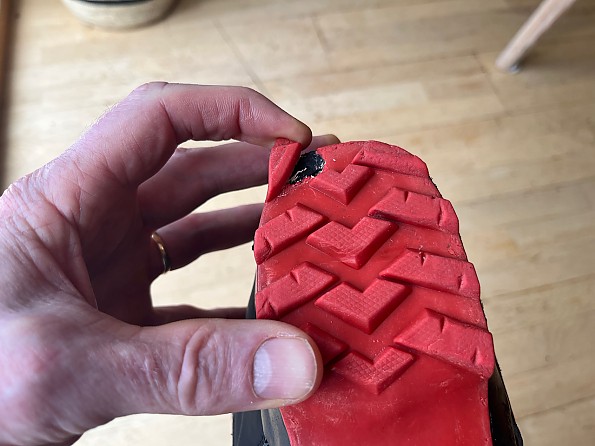
I recently had a small piece of the heel tear partly loose. I contacted both Rottefella, who designed and produces the sole (I think) and Alfa. They bounced me back to the vendor, Fjellsport, a big online company based in Oslo that offered a great package price when I first bought the boots. Alfa has a two year warranty. The damage occurred just a few days before the two years were up, and it wasn't until the next week that I got around to contacting them, but I sent a dated photograph that I took on the day I noticed the damage. Alfa, via Fjellsport, is honoring the warranty and sending me a new pair. So kudos to all involved—but I hope future versions of Xplore boots have a more robust heel.
There is no groove or ledge on the heel for a cable (should anyone want to develop a cable add-on for Xplore) or crampon levers. These boots aren’t especially light—my size 46s weigh a few grams over 1 kg (2.2 lbs) each—but they are only about 2/3 the weight of my rando boots.
About BOA
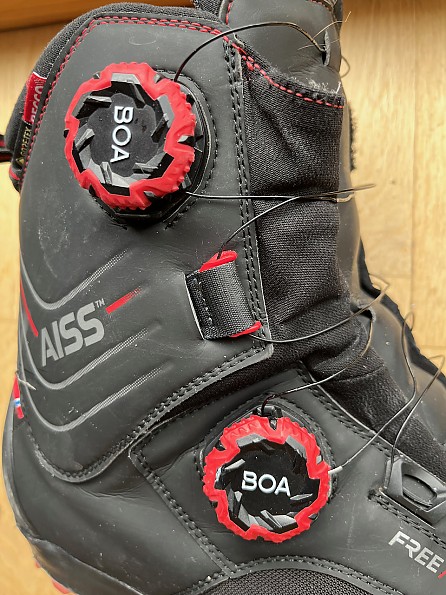
The BOA lacing system consists of ratcheted knobs that twist to tighten up tough stainless steel laces that run through low-friction plastic fittings on the boot or shoe. The name seems to refer to the coiling of the lace inside the knob, like a boa constrictor around its victim. Variations of the system are turning up on ski and snowboard boots, hiking and climbing boots, cycling and running shoes, and so on—even a pair of nordic ski gloves.
The Free boot employs independent BOA laces on the forefoot and ankle, so I can leave the ankle loose for touring and climbing while keeping the forefoot snug, then reach down and crank it tight at the top of a downhill run, more easily than adjusting buckles on some of my other backcountry and rando ski boots.
The BOA system is fast and convenient, without any of the sequential tightening required to snug a lace-up boot. To exit the boot, pull upward on the knobs to disengage the ratchet so that the laces spool out freely. I find that an upward tug on the tongue helps open up the boot and loosen up the laces for easy reentry. That convenience extends to a midnight trip to the outhouse while staying at a hut– just slide right in, give the knob a twist and head out across the snowy path to do your thing.
BOA is guaranteed for the life of the boot. If any parts break BOA will supply a free repair kit. As far as I can tell that applies to the thin wire laces that seem like, despite being "stronger than tank armor" (?), they'd have to break sooner or later, but so far they have held up even in the presence of ski edges.I have had one of the laces somehow get crossed on the spool, so that it locked up and I could barely get my foot out of the boot. It took some internet investigation and a lot of fiddling, but no new parts, to fix. I wouldn’t look forward to doing that by candlelight in a warm hut (or headlamp in a cold tent) but at least it’s possible.
The good news is that it hasn’t happened in well over a season’s worth of use since that one time. But maybe there’s something to be said for laces and buckles after all. Alfa has a lace-up, high top Xplore model, the Skaget, the seems to be essentially the same boot with conventional laces that might be of interest to folks who aren’t ready to try BOA.
Fit and Feel

Alfa notes that the Free is cut a bit large with extra room for heavy socks, and I’d agree. My usual size 46 feels a little loose with thin socks but can be snugged tight with the BOA, and room for more sock is good for skiing in cold conditions. With the ankle BOA left a little loose I have good ankle flex for touring without heel movement. The ankle can be cranked down uncomfortably tight, but I find I get good performance if I leave it a few clicks looser. In that intermediate position the tongue to tends to drift off-center so that the hard edge of the upper can dig uncomfortably into my ankle. That problem seems to have faded with break in and use, but can still happen. I have had zero blisters on the job.
Some early reviews of the boot mention that the bend in the forefoot can be uncomfortable when the boot is flexed hard in a telemark turn. I experienced this at first but for me the boots have become quite comfortable after a break-in period.
A problem (solved?)
During my first winter using these boots, I pulled over at the top of one of my favorite runs in Bymarka and took my skis off to peel skins. When I went to put one ski back on, the boot wouldn’t click into place. I discovered that one of the pins was jammed in the retracted position.
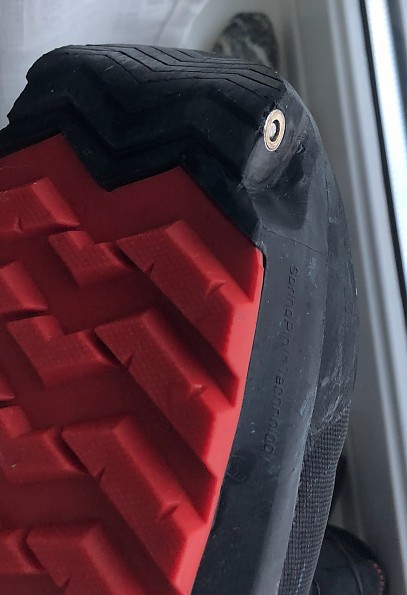
I fiddled with it for a while but couldn’t get it to pop out, and so eventually walked down a steep xc trail until it flattened out and then unhappily one-ski scootered home, about 8 km total. With some searching I found out that others in Norway had, mostly within the previous week or so, experienced the same problem. I contacted the retailer who referred me to Rottefella, which takes responsibility for the boot sole-and-binding parts of the system. They latter said it was a manufacturing defect specific to the Free boot and replaced all four pins for free, covering all shipping costs, and sent me a few goodies to smooth things over—kudos for that.
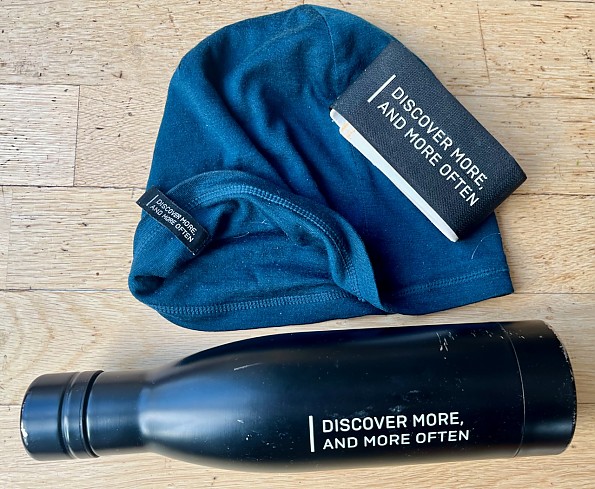
I haven’t had any problems since, but I’d really hate for that to happen in a windy, whiteout snowstorm late in the day halfway between huts. That was during the 2022 season—I have searched for more reports and as of halfway through winter 2024 haven’t found any, so maybe replacing the pins solved the problem. It does make me wonder it the pins might be vulnerable to damage from rocks or other hard surfaces during an approach or while scrambling to a rocky summit, both of which I see as normal usage for a backcountry boot.
The proof is in the powder
I haven’t yet met a backcountry system type boot that can deliver the power and control of a plastic boot, telemark or rando, on hard snow or in difficult snow conditions. That includes the Alfa Free. But I’ve had a lot of fun in these boots in powder, corn, and even mashed potato snow, mostly doing big swooping teles on mellow terrain, but also with the occasional steep shot requiring tightly linked, unweighted parallel turns.
While some of the fun is in teasing performance out of a less than ideal setup (as in the early days of tele skiing), there is also some real advantage to a lightweight, versatile system that tours well whether on the long approach to the Goodness or a hut-to-hut journey. The Alfa Free does its part to deliver that kind of versatility, with the convenience of BOA and the step-in and -out Xplore binding.
With its ankle stiffeners and BOA laces, the Free seems to be the high-end boot for the Xplore binding system. It can drive a big Norwegian-style mountain ski like the Rabb 68, and in real powder country could probably go even bigger, in a system that runs at ½ to 2/3 the weight of full-bore telemark and rando rigs. So far it has served me well over two seasons’ worth of backcountry skiing, including descents of varying difficulty. It is a pleasure to ski in powder (but so are a lot of other skis). I’d recommend it highly for everything from poking around backyard woods with an occasional powder run to the more demanding hut-to-hut and mountain touring that I have used it for.
Background
I have been a skier for over 60 years and a backcountry and telemark skier for over 40. I did my first hut-to-hut tours in Norway during a visit in 1984, and have done many more in the 20+ years that I have lived here, usually with summit ascents and descents along the way. I have put in two full seasons with the Alfa Free as my main all-round backcountry boot. I use rando gear for ski mountaineering on steeper terrain, usually only on day trips.
Source: bought it new
Price Paid: About NOK 3600 ($360)


